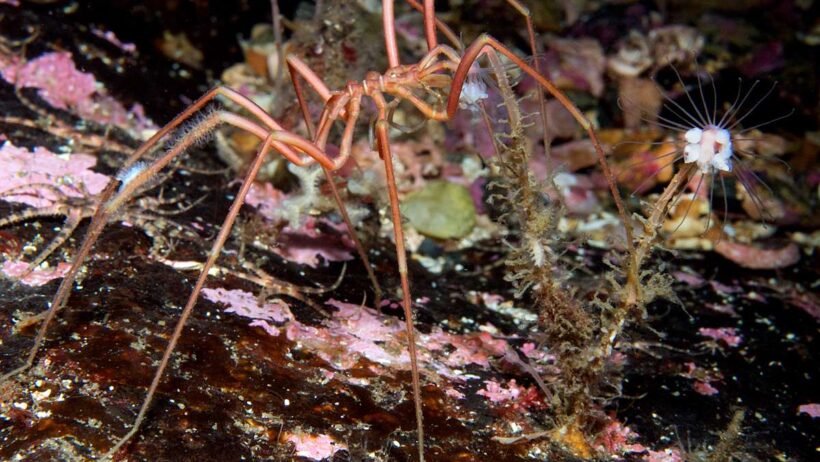In the frigid depths of our oceans resides an enigmatic creature, the sea spider, a remarkable testament to the intricacies of evolution and survival. With a body that seems more an artistic flourish than a biological necessity, these arachnids, belonging to the class Pycnogonida, have adapted magnificently to their aquatic environments. A testament to nature’s ingenuity, they embody the concept of energy conservation in a world often dictated by competition and resource scarcity.
The sea spider’s survival strategy is a masterclass in minimalism. Imagine a ballet dancer, effortlessly gliding across the stage; the sea spider moves through currents with a grace that belies its delicate form. With an exoskeleton that is light and largely hollow, it is equipped to navigate the challenges of a low-nutrient environment, allowing it to conserve energy efficiently. Instead of the bulky, muscle-bound physiques seen in many sea creatures, sea spiders flaunt a physique that defies the heft of the oceanic realms. This unique structure minimizes energy expenditure while maximizing mobility.
Central to their energy conservation is the process of respiration. Unlike most other arthropods, sea spiders lack gills. Instead, they rely on diffusion to absorb oxygen directly through their thin exoskeletons. This evolutionary quirk is particularly advantageous in their often-limited habitats, where the availability of oxygen can fluctuate dramatically. The thinness of their body allows them to absorb nutrients efficiently, akin to a sponge soaking up water, thus facilitating both respiration and nutrition through the same thin membrane. Through this mechanism, sea spiders exhibit an exquisite alignment with the elemental forces of nature, where efficiency reigns supreme.
An intriguing facet of a sea spider’s survival strategy is its diet. Predominantly scavengers, they dine on the soft bodies of hydroids and small invertebrates, employing a unique proboscis to extract nutrients. This feeding strategy is not just a personal choice but a calculated move in a world where caloric intake is paramount. By employing this specialized feeding apparatus, they minimize energy output while maximizing nutrient intake. In essence, the act of feeding becomes a careful dance of efficiency, showcasing an ability to thrive where others might falter.
Moreover, the sea spider’s reproduction is another marvel of efficiency. They exhibit an intriguing practice of carrying their eggs on their bodies, often on their legs. This behavior not only provides protection to the developing eggs but also ensures that the adult spider does not expend excess energy seeking safe nesting sites. This arrangement is reminiscent of a parent holding a child close, safeguarding their future with minimal energy investment while ensuring that they are prepared for a harsh world.
Moreover, in the context of energy conservation, the sea spider’s habitat is of paramount importance. They are often found in deeper waters, where temperatures are much more stable and where energy-dense prey are more prevalent. By inhabiting such environments, sea spiders diminish the strain of thermoregulation that dominates life in more temperate or shallow waters. Their preference for these ecological niches is akin to a wise sage selecting a serene mountaintop for meditation—where external stresses are reduced, allowing for deeper, energy-conserving introspection.
Additionally, their slow reproductive rates echo nature’s wisdom in conservation. By producing few eggs but investing considerable care in them, they embody an elegant strategy that reflects a keen understanding of their ecological role. In stark contrast to the more fecund creatures of the sea, sea spiders utilize a principle of quality over quantity, ensuring that their offspring are well-equipped to face the challenges of their environments.
Furthermore, the sea spider’s vibrant coloration serves another purpose. It may appear extravagant in the realm of energy conservation, but these hues often act as a form of camouflage, allowing them to blend seamlessly with their surroundings. By avoiding predation, they conserve not only energy but also their very lives. This intricate interplay of nature’s colors reveals a deeper understanding of the ecosystems they inhabit, where every hue tells a story of survival.
Yet, despite their fascinating adaptations, sea spiders face unique challenges in our changing climate. Increasing ocean temperatures and acidification pose significant threats to their delicate existence. As the waters warm and habitats are disrupted, the equilibrium they have so expertly maintained could tip, threatening not just their survival but the balance of their ecosystems. This situation serves as a clarion call for conservation, urging us to recognize and protect these tiny survivors who inhabit the unseen depths of our world.
In conclusion, the sea spider, with its minimalist construct and intricate adaptations, stands as a compelling embodiment of energy conservation in the animal kingdom. Through its unique physiological traits, specialized feeding strategies, and parental investment, it serves as a beacon of survival in the harsh ocean depths. As stewards of the Earth, we must acknowledge and protect the delicate threads of life these creatures represent. Their existence is not just a testament to the resilience of life but a reminder of our intrinsic connection to the natural world—a connection that we must strive to preserve against the rising tides of change. Nature’s tiny survivor is both an enigma and an imperative, urging us to tread lightly and honor the intricate web of life we inhabit.







